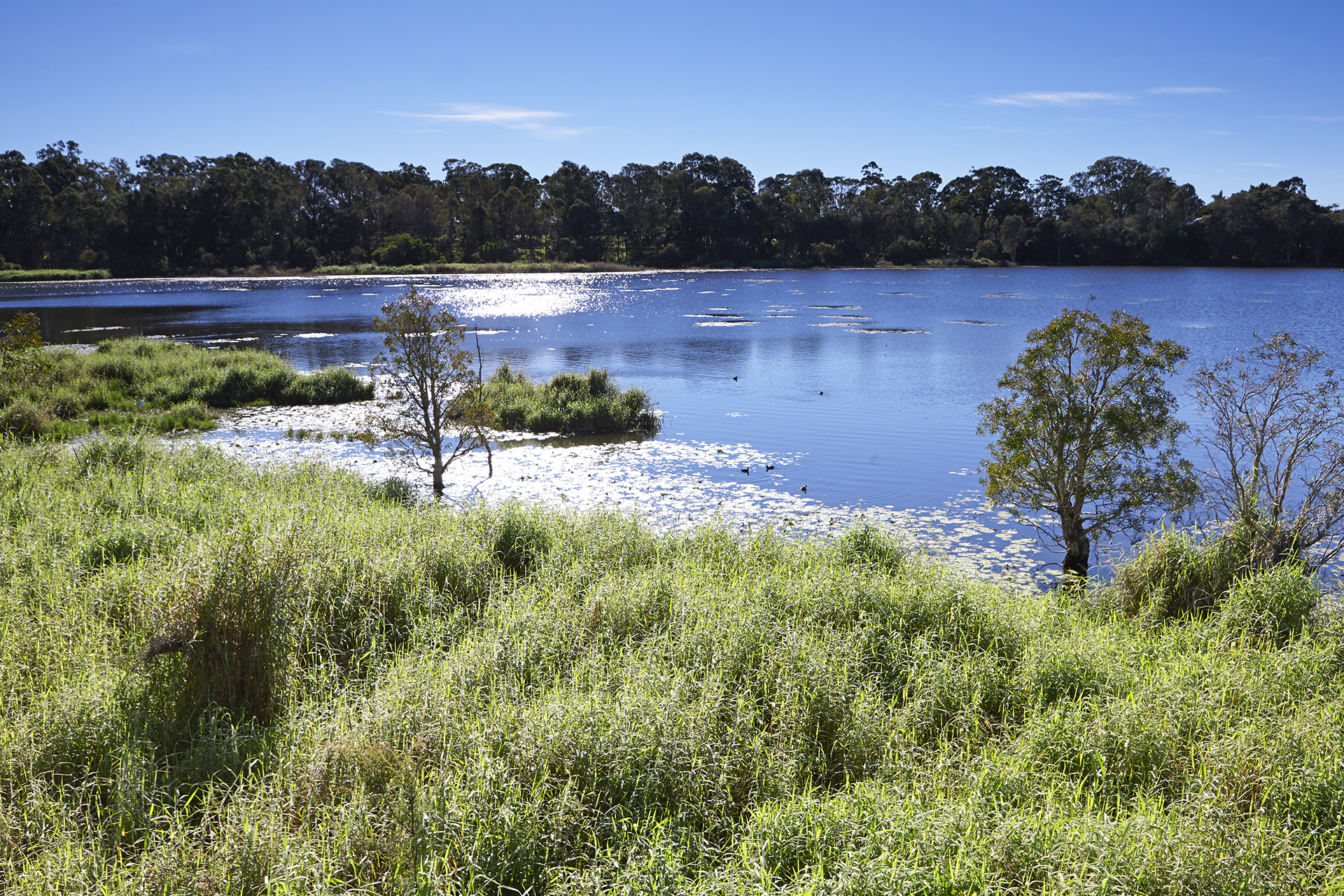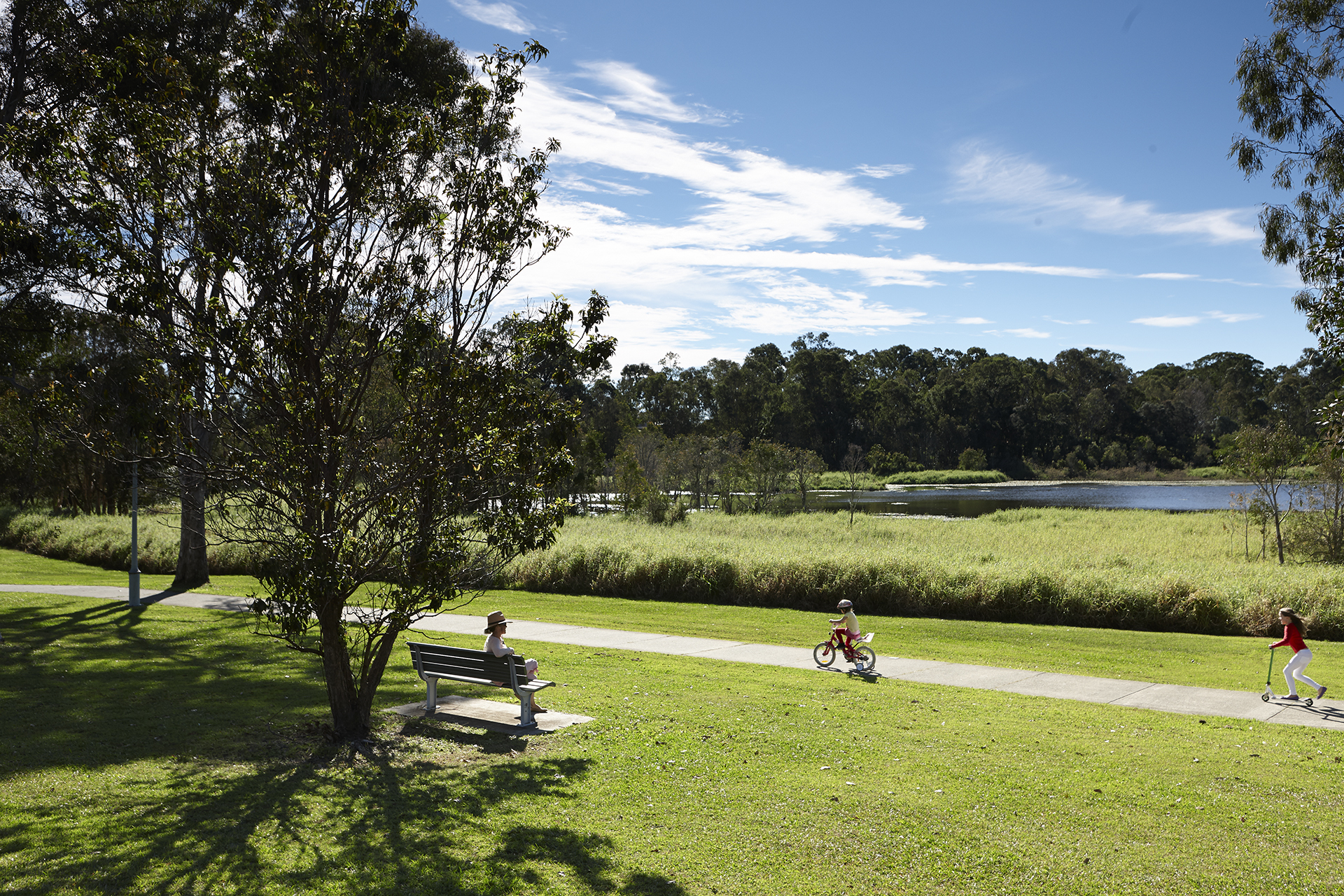Addresses
Type of place
Natural feature, Park
Period
Pre-convict settlement to 1824
Addresses
Type of place
Natural feature, Park
Period
Pre-convict settlement to 1824
As a distinctive natural landscape feature, Dowse Lagoon is important for its association with the development of the pattern of settlement and urban fabric of the district. Important as part of a complex ecosystem of wetland parks, Dowse Lagoon has been degraded and endangered by changes in hydrology resulting in weed infestations fed by toxic run-off from the surrounding roadways and properties. A landscaped retreat within the urban fabric, Dowse Lagoon is important as a place for the local and wider community to meet and relax informally. Accommodating the Sandgate Scout Group and Bowls and Croquet Clubs, the lagoon reserve is important for its association with community organisations in the district. A freshwater lagoon in the heart of an urban area providing a scenic backdrop to the business centre of Sandgate and a habitat for a range of waterbirds, Dowse Lagoon is an important visual element in the streetscape and is important for the expansive views afforded across the Lagoon. Named for early settler and Sandgate promoter Thomas Dowse, the Lagoon is important as a reminder of the early settlement of Sandgate.
Lot plan
L293_SP159020; L239_CP910671; L241_SL8164; L403_S2716
Key dates
Local Heritage Place Since —
Date of Citation —
Criterion for listing
(A) Historical; (B) Rarity; (E) Aesthetic; (G) Social; (H) Historical associationInteractive mapping
Lot plan
L293_SP159020; L239_CP910671; L241_SL8164; L403_S2716
Key dates
Local Heritage Place Since —
Date of Citation —
Criterion for listing
(A) Historical; (B) Rarity; (E) Aesthetic; (G) Social; (H) Historical associationInteractive mapping
History
The bayside suburb of Sandgate was known to the indigenous people as “Moora” or “Warra” - open sheet of water. The area offered abundant food resources in the lagoons, mangroves and bushlands. Sandgate has undergone several periods of accelerated development since European colonists first accessed Moreton Bay in 1842. The first land sales took place in 1853 and settlers soon moved into the area taking up land on traditional Aboriginal camp sites located in the open woodlands, surrounding the lagoons, swamps and waterholes and along the sandy foreshores of the bay. The lagoons, long a haven for wildlife became a popular spot for hunting, fishing and duck shooting and were valued for their scenic contribution to the townscape. Scenic natural features dominating the landscape, the lagoons influenced the pattern of settlement of Sandgate. The town centre established itself adjacent to Einbunpin Lagoon and development spread around this Lagoon and across and around Dowse Lagoon. A haven for local birds, eels and turtles located north of the centre of Sandgate, Dowse Lagoon forms a picturesque water park focus for the civic and community activities and residential properties surrounding it.
Dowse Lagoon is a wetland park within a group of wetland parks that form Deagon Wetlands which includes a number of smaller wetland parks – Deagon Wetlands Reserve, Third Lagoon, Dowse Lagoon, Einbunpin Lagoon and Brighton Wetlands. These wetlands belong to a string of coastal wetlands in Brisbane’s east and lie on old alluvial plains. These soils become waterlogged after rain, forming swamps and lagoons. The lagoons are not connected by underground aquifers as was earlier supposed, but are individually fed by rain and run-off.
The Lagoon provided a ready source of water for the town of Sandgate prior to the provision of reticulated water in the 1920s. A hand pump was installed on the south edge of the Lagoon to pump water to the water carts. With the encroaching urban settlement, the Lagoon has been plagued with water quality concerns and weed infestations.
Dowse Lagoon is named for the first European settler in the Sandgate area, Thomas Dowse.
Thomas Dowse was born in Hackney, London. In 1824, aged thirteen or fourteen, Dowse was convicted and sentenced to death for stealing clothing from his brother. Dowse had his sentence commuted to life imprisonment and in 1828 was transported to the penal colony in Sydney. He received a conditional pardon in 1840 and arrived in the Moreton Bay area in 1842. He established a ferry service across the Brisbane River in 1843 and soon after opened an office and store in Queen Street. The first sale of town and suburban allotments in Brisbane was held in 1844 and was conducted by Dowse, acting as Government Auctioneer. In the following year he established his own business as an auctioneer and commission agent. An entrepreneurial investor, his interests were many and varied. He was a census collector in 1846 and 1851; in the 1850s he was actively involved in the movement towards separation from New South Wales; he was involved in the first circulating library in Brisbane; he was the Moreton Bay correspondent for the Sydney Morning Herald, an active journalist with the nom-de-plume “Old Tom” reporting regularly to Sydney Town the news of the Moreton Bay area; from 1862 to 1869 he was Brisbane’s first Town Clerk. He died in 1885.
He is recognised for his active promotion of Sandgate as a business and holiday settlement.
The early development of Sandgate was related to changes in shipping after the northern passage between Bribie and Moreton Islands was favoured over the southern entry to the bay. The southern route between Moreton and Stradbroke Islands was less costly to the shipping companies but more dangerous. After 1848 the pilot station was shifted north from Amity Point on Stradbroke Island to Cowan and then Bulwer on Moreton Island and a new connection was needed between Moreton Island and Brisbane via a northern bayside location. The Cabbage Tree Head locality entered into serious contention as a port and a resort.
By 1851 speculators were promoting Cabbage Tree Head as an alternative to Cleveland as the major shipping town. Lieutenant C.B. Yule surveyed the bay in HMS Bramble and discovered that good anchorage was available three miles out from the edge of the sandbank which extended half a mile beyond Cabbage Tree Head. It was considered that “Yule’s anchorage”, the provision of landing facilities at Cabbage Tree Head and a good road between the district and Brisbane would compensate for the problem of an undredged Brisbane River which prevented direct traffic with large vessels. It was envisaged that whalers and merchantmen could provision directly from the shore, sailors could rest after a long sea journey with little likelihood of absconding and shipping news could be conveyed rapidly to Brisbane. It appeared that Cabbage Tree Head was set to develop as a significant northern port if its promoters were successful and government decisions went in their favour.
Anticipating a profitable venture, Dowse became an activist for the development of the locality. In the largest land sale held till then in Moreton Bay, on 9 and 10 November 1853 the first allotments at Sandgate and Cleveland were auctioned. The Brisbane courthouse overflowed and high prices were obtained after fierce competitive bidding. It was considered that either location could become the seaport for the district but with the pastoral expansion occurring north of Brisbane and agricultural enterprises advocated for the Pine and Caboolture areas, Sandgate supporters had good reason to be optimistic. Dowse managed to secure three allotments contiguous to the proposed wharf at the mouth of Cabbage Tree Creek.
The indigenous population of the Sandgate area worked to actively discourage European intrusion onto their lands. Thomas Dowse and his two eldest sons were lucky to escape with their lives when they attempted to clear their land and erect a rough hut at Cabbage Tree Head, just days after the 1853 land sales. Hoping that Cabbage Tree Creek might develop into a provisioning depot for whalers and merchantmen, Dowse was active in promoting the settlement predicting future volumes of shipping “at anchorage, abreast of the town”, waiting for “the flood to run up the rivers Brisbane and the Pine” or for “sailing orders to proceed to sea”. He also spoke of the economic benefits to be had with the taking up of proposed agricultural holdings, the working of large stands of fellable timbers and the harvesting of the abundant supplies of seafood.
An obvious impediment to Sandgate’s popularity and prosperity was the poor state of communication and transport with the town of Brisbane. The Brisbane-Sandgate road was improved during the mid-1860s, possibly influenced by the agitation of Dowse, who was Brisbane’s town clerk at the time. Cabbage Tree Creek was bridged in 1864-65 causing the Courier to observe that “The Government are acting well by Sandgate, for a new road has been marked out, and a capital bridge over Cabbage Tree Creek is nearly finished, which will enable us to get there within two hours”. At a public meeting in 1865 Dowse promoted the proposal for constructing a pier near Cabbage Tree Creek which would provide a landing place for holidaymakers, day-trippers or commuters to Sandgate, Brighton, the Pine and Humpy Bong. When it was discovered that an extensive sandbank off Sandgate uncovered at low tide proved to be a major impediment to shipping, the deepening of the Brisbane River was viewed as a more economical alternative. The 1866 depression curtailed further interest in the pier proposal and the new railway was not planned to reach the proposed jetty at Cabbage Tree Creek. Not surprisingly Dowse sold out his Cabbage Tree Creek holdings about this time. Dowse did not set up permanent residency in Sandgate.
Despite the speculative hopes of promoters of Sandgate and Cleveland, Brisbane retained its status as the chief town and port of the north.
Description
Dowse Lagoon occupies an irregular wedge of land covering an area of 21.87 hectares bounded by Deagon Street, Brighton Road, Keogh and Southerden Streets, Sandgate. Expansive views are obtained across the lagoon from most points around the perimeter. Notable is the view from the north towards the striking form of the Sacred Heart Church visible above a wide expanse of water and lush vegetation.
An oblong freshwater lagoon located in open parkland northwest of the business centre of Sandgate, Dowse Lagoon provides a habitat for a range of waterbirds including domestic ducks and geese. Ninety-eight species of birds have been recorded on the site. A concrete walking path circuits the lagoon which is surrounded by grassed areas accommodating picnic facilities and scattered with clumps of eucalypts, melaleucas and other decorative and shade trees. Reeds and weeds grow to the edge of the lagoon. A tree covered island has been constructed towards the centre of the lagoon.
The Sandgate Scout Group Hall stands within the reserve, east of the lagoon facing onto Brighton Road. A rectangular freestanding timber pavilion with a large central gabled volume flanked by low enclosed verandahs with low pitched roofs, the Hall is distinguished by a large camphor laurel standing onto Brighton Road. A small freestanding brick toilet block stands northwest of the Scout Hall.
Facilities for the Sandgate Bowls Club and Sandgate Croquet Club are accommodated to the southeast corner of the lagoon reserve.
Statement of significance
Relevant assessment criteria
This is a place of local heritage significance and meets one or more of the local heritage criteria under the Heritage planning scheme policy of the Brisbane City Plan 2014. It is significant because:
References
-
Brisbane City Council - City Assets Branch Conservation Management Study Stage 1 Report. November 2002
Citation prepared by — Brisbane City Council (page revised August 2023)


